Navigating the Dragon's Wake: India and the Philippines Forge a New Indo-Pacific Alliance in the South China Sea
The inaugural India-Philippines joint naval drill in the South China Sea signals a new Indo-Pacific alliance, challenging China's aggressive claims and reshaping regional power dynamics.
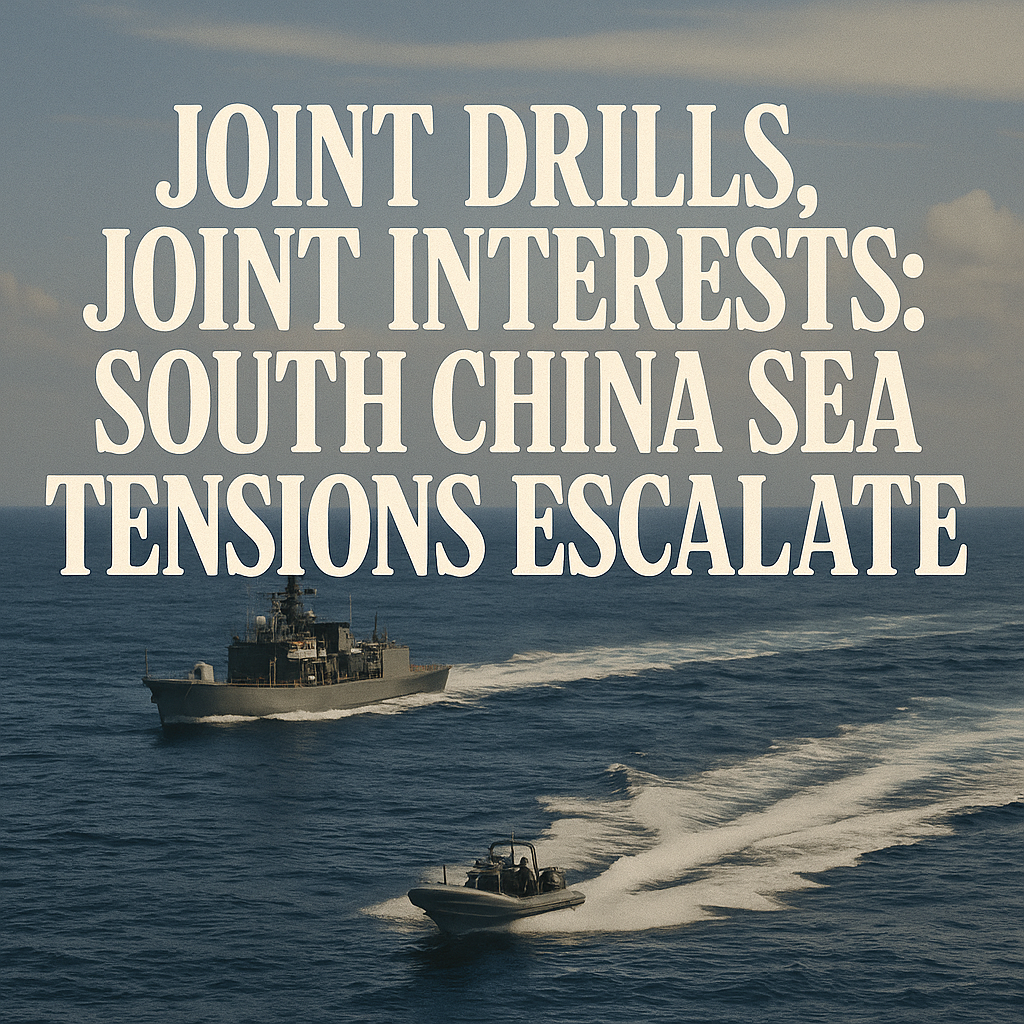
Written by Lavanya, Intern, Allegedly The News
MANILA, Philippines – August 5, 2025
The South China Sea (SCS) is a critical artery for global trade, with an estimated $3 trillion in annual shipborne commerce. Its geopolitical importance is amplified by overlapping territorial claims, notably China's "nine-dash line," fueling tensions with claimants like the Philippines. The recent inaugural joint naval drill between India and the Philippines marks a pivotal moment in Indo-Pacific security dynamics. This exercise signifies a growing strategic alignment between two democracies, driven by shared maritime security concerns and a rules-based international order. It's a critical evolution within India's "Act East Policy," signaling a deliberate shift to counterbalance China's influence.
This alliance clarifies India's commitment to its Indo-Pacific vision, moving beyond rhetoric to active engagement in contested zones. India's participation, given its historical non-alignment, further internationalizes SCS disputes. While China advocates for bilateral resolution and warns against "third-party intervention", the Philippines has actively sought partnerships with "like-minded nations," including the US, Japan, Australia, New Zealand, and France. India's involvement broadens this coalition, making it harder for China to frame the SCS issue as purely bilateral, forcing Beijing to contend with more states upholding international law.
India-Philippines Joint Naval Drill: A Symbolic and Operational Statement
The first India-Philippines joint naval exercises took place August 3-4, 2025, in the disputed South China Sea, within the Philippines' EEZ, near Scarborough Shoal, an area China effectively controls.
Participating naval assets underscore their significance. The Indian Navy deployed INS Delhi (guided-missile destroyer), INS Shakti (fleet tanker), and INS Kiltan (anti-submarine warfare corvette), with INS Sandhayak also visiting Manila. The Philippine Navy contributed frigates BRP Miguel Malvar and BRP Jose Rizal.
Philippine military chief Gen. Romeo Brawner confirmed two Chinese navy ships, including a guided-missile destroyer, shadowed the drill from about 25 nautical miles. Brawner noted no "untoward incident" occurred, but it was "expected." Operations focused on joint maneuvers, communication protocols, and replenishment-at-sea to improve preparedness, trust, and synergy. The overall intent was to enhance interoperability and demonstrate support for the Philippines.
The exercise's timing amplified its strategic message, coinciding with Philippine President Ferdinand Marcos Jr.'s state visit to India. This transformed the military deployment into a high-profile diplomatic statement aimed at boosting defense, trade, and investment ties. This dual nature amplified its impact. Conducting the drill near Scarborough Shoal and anticipating Chinese shadowing indicates a calculated decision by Manila. The Philippines also allows journalists on patrols to document China's actions, suggesting a strategy of assertive transparency that shifts the onus of escalation to China and garners international attention.
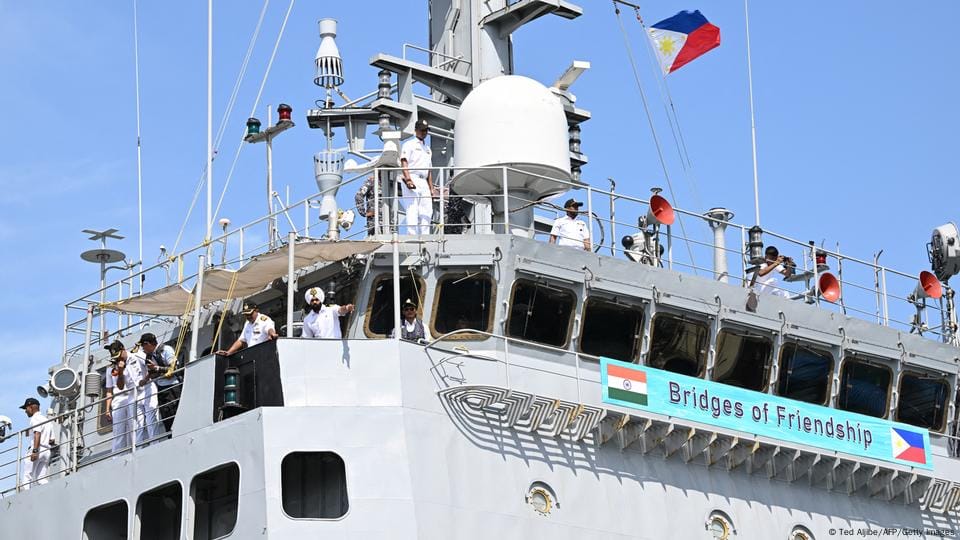
India's Evolving Maritime Strategy and Footprint in the Indo-Pacific
India's foreign policy has transformed significantly since the Cold War. The 1992 "Look East Policy" focused on economic integration with Southeast Asia, evolving into the more ambitious "Act East Policy" in 2014 to cultivate extensive economic and strategic relations. A key objective of "Act East" is to mitigate Chinese dominance in the SCS and Indian Ocean, reflecting India's aspiration for international maritime influence.
Over the last decade, India has embraced a "net security provider" role in the Indian Ocean Region (IOR) and Indo-Pacific. This shifts its maritime strategy from coastal defense to proactive policing, patrols, and surveillance, securing vital sea lanes (SLOCs). India's engagement responds to China's expanding maritime presence, often seen as a "string of pearls" strategic encirclement. Recent deployments of Indian Navy warships to Manila and Singapore visibly expand India's naval footprint in Southeast Asia, demonstrating a commitment to strengthening partnerships and projecting power. This strategic diversification is evident in India's provision of advanced defense technology and new security partnerships, positioning it as an independent pole in Indo-Pacific security.
Defense cooperation with the Philippines accelerated. In 2022, the Philippines became the first country to procure India's BrahMos supersonic cruise missile system. Manila is exploring further acquisitions, including the Akash air defense system .Philippine Chief of Staff Gen. Romeo Brawner Jr. confirmed plans to order "more equipment and weapon systems from India" due to their quality and cost-effectiveness. These transactions are strategic tools for India to cultivate security partnerships and expand its defense industry.
Crucially, India revised its stance on the 2016 South China Sea Arbitration ruling. Previously "acknowledging" it, New Delhi now explicitly "calls for adherence to the award" as of July 2023. This directly supports Manila's claims and counters China's expansive claims, providing a robust legal-diplomatic foundation for India's increased military presence and cooperation in the SCS.
Timeline of Key India-Philippines Defense Cooperation Milestones (2022-2025)
| Date/Pd. | Milestone | |
| Jan 2022 | Philippines procures BrahMos supersonic cruise missiles from India. | |
| July 5, 2023 | India revises its stance on the 2016 South China Sea Arbitration, calling for adherence to the award. | |
| April 2025 | Philippine Defense Secretary announces a second batch of Indian-made missiles. | |
| Aug 1, 2025 | Indian Navy ships (INS Delhi, INS Shakti, INS Kiltan, INS Sandhayak) dock at Manila for goodwill activities. | |
| Aug 3-4, 2025 | First-ever India-Philippines joint naval drill in the South China Sea. | |
| Aug 4-8, 2025 | Philippine President Ferdinand Marcos Jr. conducts a state visit to India. | |
| Ongoing | Philippines explores further defense acquisitions, including India's Akash air defense system. |
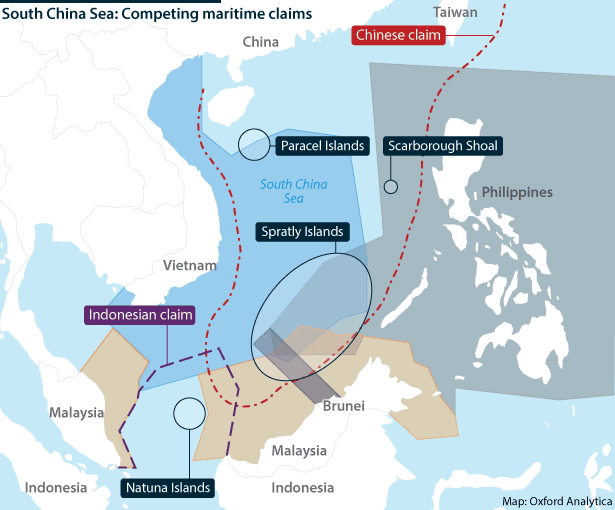
The India-Philippines Alliance: A Counterbalance to China's Assertiveness
The Philippines seeks to enhance deterrence against China's escalating aggression in the South China Sea. Manila aims to modernize its Armed Forces and partner with "like-minded nations" to promote freedom of navigation and fortify defenses against Chinese incursions. The alliance with India reaffirms a shared commitment to maritime security, regional stability, and a rules-based international order, adhering to UNCLOS.
India's SCS strategic interests are multifaceted. It shares a long-standing rivalry with China, including a contentious Himalayan border dispute. Economically, half of India's foreign trade transits through the Strait of Malacca to the SCS, making secure navigation vital. India's "Act East Policy" and ambition to be a global power also drive its involvement, balancing its IOR security provider role with broader Indo-Pacific aspirations.
The India-Philippines alliance directly responds to China's expansive claims and aggressive actions. Since President Marcos Jr. took office, the Philippines has shifted to a more assertive, confrontational posture against China. The alliance strengthens deterrence and upholds international law against China's unilateral assertions.
Manila's strategy of "partnering with like-minded nations" and its existing collaborations with the US, Japan, Australia, New Zealand, and France exemplify a "distributed deterrence" model. India's inclusion expands this network, collectively raising costs for China's actions and adapting to its grey-zone tactics. While allied with the US, the Philippines' deepening ties with India, including BrahMos missile and potential Akash air defense system procurements, diversify its security partners and enhance strategic autonomy. This multi-partner approach, with India offering cost-effective defense hardware, reduces dependence and increases flexibility, making the Philippines more resilient.
Recent Chinese Coercive Actions in the South China Sea (2024-2025)
| Type of Action | Specific Incidents/Tactics | |
| Increased Coercion | Against Philippine naval vessels, Coast Guard, and civilian vessels/aircraft operating legally in the Philippines' EEZ. | |
| Water Cannon Incidents | Against BFAR boat carrying supplies to Filipino fishermen at Scarborough Shoal (Dec 2024). | |
| Physical Confrontations | CCG and militia ships ramming and boarding Philippine vessels, leading to injuries (e.g., severed thumb on June 17, 2024). | |
| Naval Presence Escalation | Deployment of 12,000-ton "monster" CCG ship 5901 to Scarborough Shoal, joining other CCG and CMM vessels. | |
| "Lawfare" Tactics | Enactment of legislation such as "Provisions on Administrative Enforcement Procedures for Coast Guard Agencies" to provide ostensible legal cover for detaining foreign vessels in "waters under Chinese jurisdiction." | |
| Military Patrols | Chinese jet fighters, bombers, and naval forces conducting "combat readiness patrols" around Scarborough Shoal. | |
| Harassment of Resource Operations | Increased CCG vessels harassing Indonesian and Malaysian oil and gas operations; diplomatic pressure on Malaysia to halt exploration near Luconia Shoals. |
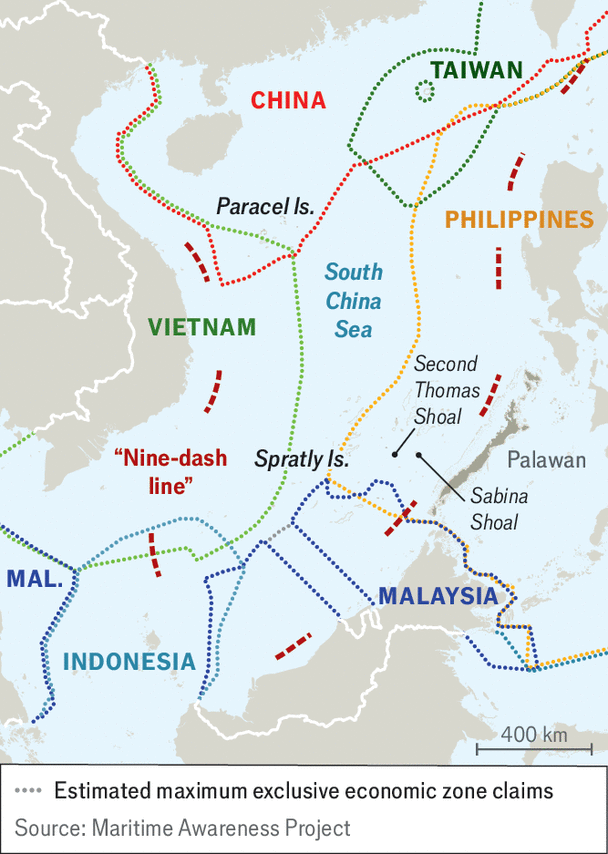
Beijing's Reactions and Strategic Calculus
Beijing's reaction to the India-Philippines joint naval drill was swift and critical, reflecting its stance on external involvement in the SCS. China's Southern Theater Command conducted "routine patrols" concurrently, asserting its resolve to defend sovereignty. Without naming India, it accused the Philippines of "drawing in outside countries" to "undermine regional peace." China's Foreign Ministry insists disputes be resolved bilaterally, without third-party intervention. China's Ministry of National Defense previously called the Philippines a "troublemaker" for aligning with foreign forces.
Chinese state media, like the Global Times, dismissed the drills as "largely symbolic," "gesture politics," and "more symbolic than substantive," suggesting they offered "fake commitments" and aimed to "peddle Indian weapons."This narrative seeks to downplay the alliance's impact and deter similar cooperation. However, this dissonance suggests China is genuinely concerned about India's involvement and SCS internationalization, even as it projects unconcern to discourage further external engagement.
Beijing's "routine patrols" align with its broader strategy of increasing coercion against Philippine vessels and aircraft, using "grey zone violence" like water cannon attacks, ramming, and enacting legislation to justify detentions. This indicates China's coercive diplomacy, though aggressive, is proving ineffective, inadvertently pushing claimants closer to external partners. The long-standing India-China rivalry, marked by Himalayan border disputes and skirmishes, underpins Beijing's reaction. China views India's SCS involvement as an attempt to "check China" and expand influence in Southeast Asia.
Broader Regional and International Implications
The India-Philippines alliance, with India's expanding naval footprint, could reshape Asia's balance of power, potentially forming a "new Indo-Pacific power bloc" challenging China. Beijing warns India's "extraterritorial" involvement could "intensify competition" and "prolong maritime confrontations," increasing escalation risk.
A core principle is reinforcing the rules-based international order and UNCLOS. Both nations reaffirm their commitment to maritime security and stability. India's revised stance on the 2016 SCS Arbitration, now calling for adherence, directly supports the legal framework against China's claims.
The alliance aligns with broader engagement by other external partners. The Philippines conducts patrols with the US, Japan, Australia, New Zealand, and France to promote freedom of navigation and deterrence. India's participation integrates it into this wider coalition for a free and open Indo-Pacific. India's QUAD participation (Australia, Japan, US) further bolsters its Indo-Pacific engagement, promoting coordinated security. This suggests a "networked security" model: flexible, multi-layered bilateral and mini-lateral collaborations sharing the burden of upholding stability, making it resilient to Chinese pressure without a rigid military bloc.
Increased military presence and joint activities, coupled with China's responses, elevate miscalculation and accidental escalation risks. Chinese shadowing during the drill is a tangible indicator. This paradox requires careful risk management.
Implications for ASEAN's centrality are significant. While India seeks cooperation with ASEAN, the rise of bilateral arrangements like the India-Philippines alliance could challenge ASEAN's traditional role as regional security convener. A unified ASEAN stance has been hindered by members like Cambodia, leading to more prominent ad-hoc, external-backed security arrangements. This risks fragmenting regional security and marginalizing ASEAN's traditional role, making a region-led SCS solution more challenging.
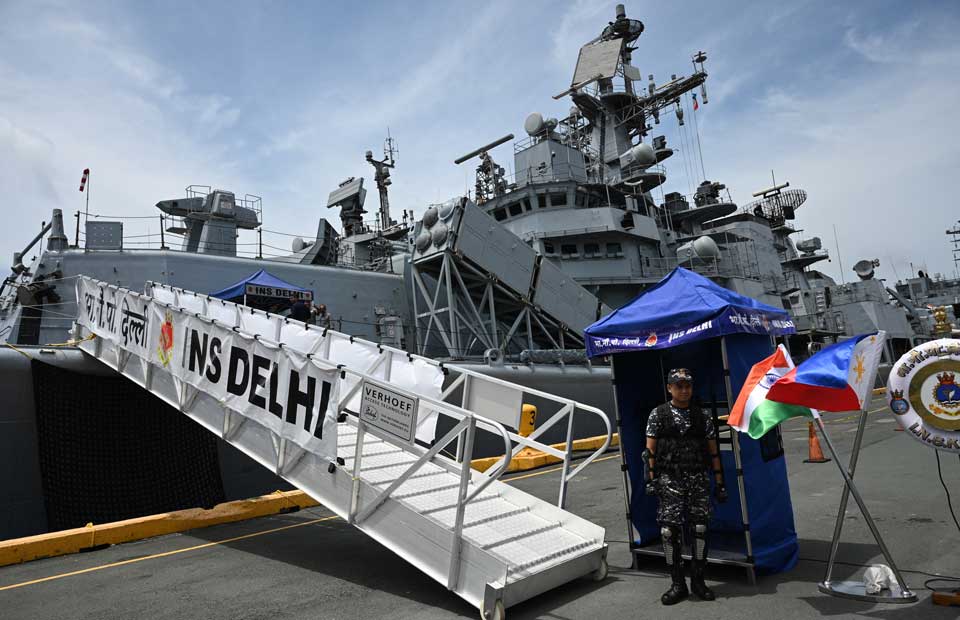
The "Distributed Deterrence" Model
The India-Philippines alliance exemplifies an emerging "Distributed Deterrence" model in the Indo-Pacific. This theory posits that rather than relying on a single dominant power or a rigid military alliance, regional stability is best achieved through a flexible, interconnected web of bilateral and mini-lateral security partnerships. Each partnership, while perhaps not individually capable of fully deterring a major power, collectively raises the costs and risks for aggressive actions, thereby creating a more resilient and adaptable security architecture. This model allows nations to maintain strategic autonomy while contributing to a broader collective defense, making it harder for any single actor to dominate or coerce.
What Happens Next? A Call to Action
The trajectory of the India-Philippines alliance is set to deepen, driven by the persistent challenges posed by China's assertiveness and the shared strategic imperatives of both nations. We can anticipate:
- Increased Interoperability: More frequent and complex joint exercises, potentially expanding beyond naval drills to include air and land components, to enhance seamless coordination.
- Further Defense Acquisitions: The Philippines is likely to continue procuring advanced defense systems from India, bolstering its indigenous capabilities and diversifying its arms suppliers.
- Diplomatic Reinforcement: Both nations will likely continue to advocate for a rules-based international order and freedom of navigation in multilateral forums, seeking to build a broader international consensus.
- Heightened Scrutiny: The alliance will remain under intense observation from Beijing, leading to continued counter-patrols and diplomatic condemnations, necessitating careful de-escalation mechanisms.
For policymakers, the call to action is clear: continue to foster and institutionalize these emerging partnerships while simultaneously investing in robust diplomatic channels. The goal must be to strengthen deterrence without inadvertently triggering escalation. Supporting the defensive capabilities of claimant states, upholding international law, and promoting transparent communication are paramount to navigating this complex geopolitical landscape.
What do you think?
To what extent will India's growing defense industry be able to meet the diverse needs of Southeast Asian nations seeking to diversify their arms procurements away from traditional suppliers? How will the increasing frequency of joint drills by various "like-minded nations" in the South China Sea impact China's long-term strategy for asserting its claims? Will it lead to a softening of its stance or a more aggressive pushback?
Sources
This investigative report draws upon information from leading news agencies, including AP, Al Jazeera, Reuters, Philstar, Tribune India, Times of India, Newsweek, NDTV, Jakarta Globe, Stars and Stripes, AFP, Getty Images, Oxford Analytica, Ted Aljibe, Maritime Awareness Project, and TRT Global. Further analysis is informed by prominent academic and policy think tanks, as well as official military and government publications.




